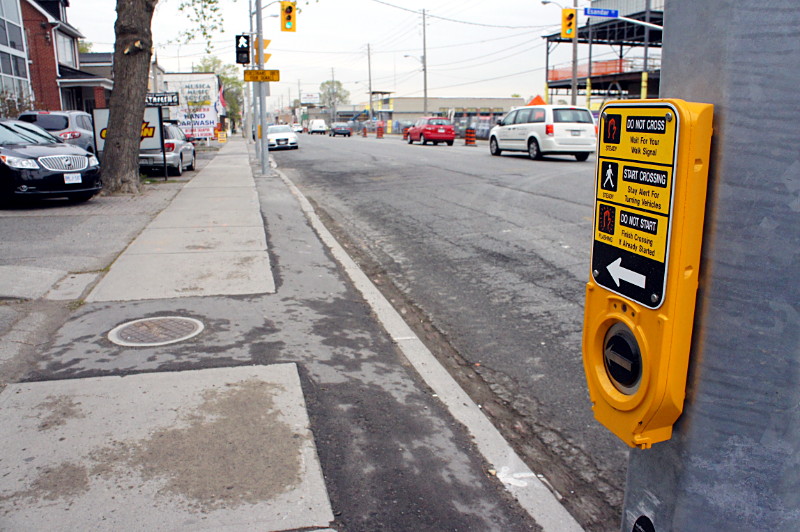In a story last week, The Fixer touched on one of my pet peeves: pedestrian signals at intersections that don’t change with the traffic signal unless you press the button. Now I understand that many signals in the city won’t change unless a vehicle is waiting or a pedestrian presses the button. That’s not what’s at issue. The problem here is that when a vehicle is present and causes the light to change, the pedestrian signal doesn’t change to “walk” unless a pedestrian also presses the button. The reverse is not true: if the signal changes in response to a pedestrian pressing the button, both the traffic and pedestrian lights change.
So why not always switch the pedestrian signal with the main traffic signal? Toronto Transportation Services calls these “Semi-Actuated Type 2” (SA2) signals and gives this explanation in their pedestrian FAQ:
Why do some signals, which have pedestrian displays, show a “Don’t Walk” indication even when the signal is green for the side-street (minor road)?
This situation occurs when a vehicle has been detected on the side-street and no pedestrian has pushed the button. This only can occur at locations where the City’s Transportation Staff has installed a Semi-Actuated “Type 2” (SA2) intersection. With this type of operation, a pedestrian must push one of the pedestrian push buttons to receive a “Walk” signal. When a button is pushed, a pedestrian will receive a “Walk” signal with sufficient time to cross the major road. If a button is not pressed and the traffic control signals respond to a vehicle only, a green signal will be displayed along with a “Don’t Walk” indication for pedestrians. The length of this green signal could be considerably shorter than the required walk time for a pedestrian because the length of the green signal is variable, based on the vehicle demand only (as the pedestrian push button was not pressed).
We use this type of operation to maximize the efficiency of the intersection. It serves to minimize delay for the relatively heavier volume of traffic on the major road.
It is the City’s practice to always install pedestrian information signs, which describe this operation at these types of intersections.
“So what’s the big deal?” you ask? Just press the button, right? Well, it’s not always that simple. First, pedestrians don’t always arrive at an intersection in time to press the button. If you’re walking up to an intersection and don’t reach the button before the light changes, you’re stuck waiting for the next cycle. Well, most people aren’t willing to wait and will simply walk across with the green light, even though they’re facing the “don’t walk” hand.
This behaviour raises at least two safety problems. First and foremost, the immediate safety of the pedestrian is at stake. Many drivers, seeing the “don’t walk” pedestrian signal, will simply power ahead with a left or right turn, completely ignoring any pedestrians that may be crossing at the time. I’ve seen this happen many times at my local SA2-signalled intersection.
The second, more insidious, effect of these signals is that they train pedestrians to ignore pedestrian signals. Most pedestrians in Toronto know by now that if they’re looking at a “don’t walk” signal but road traffic travelling in the same direction has a green light, it’s okay to walk across and ignore the big red hand. Unfortunately, this isn’t always true: pedestrian walk signals at many three phase intersections are active for only one phase, and crossing at any other time is a genuine hazard. It can be difficult for a pedestrian to tell whether a “don’t walk” signal is “legitimate” or not.
It’s one thing to bellyache about a problem, and quite another to propose reasonable alternatives. So here are two easy solutions:
- Allow a pedestrian to light up the walk signal by pressing the button after the traffic light has changed to green. Yes, this will extend the cycle by a few seconds, but it will greatly enhance safety. And it will only slow the cycle if a pedestrian is actually present. I noticed on a trip there last summer that many signals in San Francisco behaved like this.
- Failing that, just program the SA2 signals to always flip the pedestrian signal along with the main signal and forget about the few seconds potentially saved by shortening the cycle for vehicles only. The efficiency lost will be more than offset by the elimination of confusion for both motorists and pedestrians.
Above all, Transportation Services must remember than pedestrians are traffic too. Just because we’re walking doesn’t mean that we aren’t in just as big a rush to get from A to B as someone in a car.


 This is the kind of cycling infrastructure that I love: it’s incredibly useful for both casual and seasoned riders and just sits unobtrusively in the background until it’s needed. The only thing missing from the stand is a pump, which is probably the one tool that would be used the most. Susan Sauvé, a transportation planner at the city, told me via email that pumps were originally included with the stands when they were installed in July, but they all broke within a week. The city currently has more durable pumps on order from the manufacturer and hopes to re-install them soon.
This is the kind of cycling infrastructure that I love: it’s incredibly useful for both casual and seasoned riders and just sits unobtrusively in the background until it’s needed. The only thing missing from the stand is a pump, which is probably the one tool that would be used the most. Susan Sauvé, a transportation planner at the city, told me via email that pumps were originally included with the stands when they were installed in July, but they all broke within a week. The city currently has more durable pumps on order from the manufacturer and hopes to re-install them soon.







